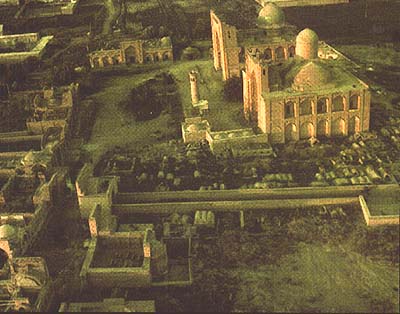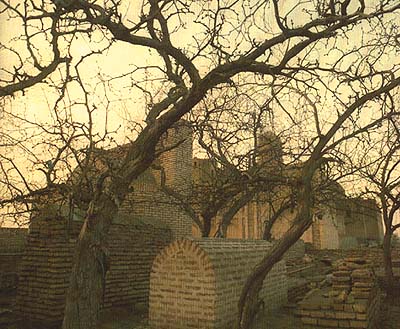When all the spaces round the Samanid mausoleum were  filled,
the Bukharan aristocracy took itself elsewhere to be buried: to the grave
of a descendent of the Prophet called Abu Bakr Sa'd, 5 km west of the city
walls near what is now the village of Sumitan. In 1558 the khan's philosophers
announced the presence of a lucky star and foundations for a monumental
necropolis were laid near Abu Bakr's filled,
the Bukharan aristocracy took itself elsewhere to be buried: to the grave
of a descendent of the Prophet called Abu Bakr Sa'd, 5 km west of the city
walls near what is now the village of Sumitan. In 1558 the khan's philosophers
announced the presence of a lucky star and foundations for a monumental
necropolis were laid near Abu Bakr's
grave. Paid for with endowments from the city's wealthiest
families, it eventually comprised two streets of tombs, a small madrasa,
and a mosque and khanaga whose huge portals, standing side by side, are
visible miles away.
Chor Bakr actually means 'four Bakrs', all descendants
of the Prophet and possibly all buried here. The charming old caretaker
confidently identifies two of their graves, neither of them Abu Bakr's.
Imam Said Bakr is buried behind the street which leads north off the main
courtyard. Go through the first arch on the right, turn left, pass eight
small brick arches, and the grave, surely one of the world's
forlornest places of pilgrimage, is under a pile of rubble
on the right. Imam Bakr Fazl's tomb is at the end of the restored brick-walkway
at right angles to the main street.
 Chor
Bakr must have been imposing once. Now it's falling down to the sound of
wind in the scaffolding which props up the khanaga, formerly the headquarters
of an order of dervishes called the Khodjagons. A pool in the main courtyard
has been filled in. Gold and lapis lazuli have gone from the domes and
vaults of the mosque. The road from the city, once lined on both sides
with willows and canals, is now just another causeway through over-irrigated
cotton fields. Few people come here nowadays, which is why it's worth the
effort. Chor
Bakr must have been imposing once. Now it's falling down to the sound of
wind in the scaffolding which props up the khanaga, formerly the headquarters
of an order of dervishes called the Khodjagons. A pool in the main courtyard
has been filled in. Gold and lapis lazuli have gone from the domes and
vaults of the mosque. The road from the city, once lined on both sides
with willows and canals, is now just another causeway through over-irrigated
cotton fields. Few people come here nowadays, which is why it's worth the
effort.
[back]
|

